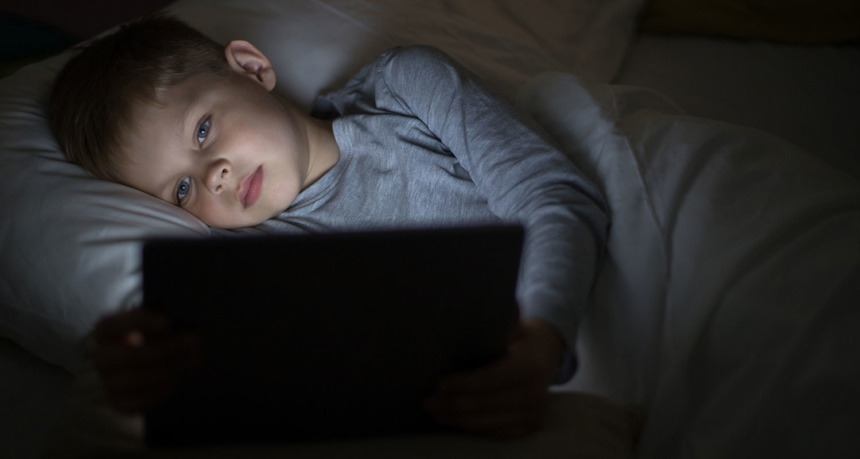You may be reading this article on a device that emits blue light. With people spending more time in front of screens than ever before, should we worry about blue light in our eyes?
Here’s an overview of blue light, how it can harm your health, and how it can help.
What is blue light?
The world pulsates with electromagnetic energy. It moves around us like waves and even within us.
The waves vary in length, with the longest being:
- radio waves
- microwaves
- infrared
- ultraviolet (UV) waves
The shortest include the electromagnetic spectrum of:
- X-rays
- gamma rays
Most electromagnetic waves are invisible. However, a small band of waves called visible light is visible to the human eye. The wave length of visible light varies from 380 nanometers (violet light) to 700 nanometers (red light).
Wavelength of blue light
The longer the wave, the less energy is transferred. Blue light has very short, high-energy waves.
In fact, they are slightly longer and less powerful than UV rays, which are too short to be seen by the naked eye. increase.
Waves of high-energy blue light are about the same intensity.
What produces blue light?
Blue light is all around you, just like any other color of visible light. The sun emits blue light. The same goes for fluorescent and incandescent lights. The prevalence of devices based on light-emitting diode (LED) technology exposes people to more blue light than ever before.
Computer and laptop screens, flat screen TVs, mobile phones and tablets all use LED technology with high levels of blue light.
What does blue light do to your eyes?
Your eyes have structures that protect them from certain types of light. For example, the cornea and lens protect the light-sensitive retina at the back of the eye from harmful UV rays.
These structures do not block blue light. The sun’s natural blue light far exceeds the amount from a single device.
Still, some eye health experts have expressed concern about blue light exposure from backlit digital screens and devices. This is because people spend so much time using them up close.
For example, a 2020 study published in the Indian Journal of Ophthalmology found that during the COVID-19 lockdown, 32.4% of the surveyed population used blue light emitting devices for 9-11 hours a day. rice field. Another 15.5% said he uses the device from 12 hours a day to 14 hours a day, likely due to changes in the way he works during the pandemic.
So far, there seems to be no confirmed concern about eye damage from blue light. Although some animal studies have shown that blue light can damage cells in the retina, ophthalmologists have found little evidence that blue light damages the retina in the human eye.
A recent exception: Doctors reported that a woman who used an LED face mask to improve her skin subsequently experienced blurred vision and retinal lesions. However, the face mask contained all three, making it difficult to determine whether this damage was caused by blue, red, or infrared light.
The researchers note that LED devices are relatively new, so no long-term studies have been conducted to measure the effects of blue light on the eye over a lifetime.
Risks and side effects of blue light exposure
While current research indicates that blue light from computer screens and handheld devices probably does not pose a serious risk to your eyes, there are some other risks to consider.
Here’s a quick look at the risks and benefits of blue light waves.
Blue light and macular degeneration
According to the American Academy of Ophthalmology (AAO), age-related macular degeneration (AMD) is the leading cause of blindness in people over the age of 50. It occurs when the macula, the structure at the back of the eye, becomes damaged with age.
As a result, you will not be able to see the center of your visual field. You may still be able to see things around you. However, details and objects in the middle of the line of sight can become blurry and difficult to see over time. Animal studies and laboratory studies have raised the question of whether blue light can accelerate the process of macular degeneration. I don’t think there is a clear link.
Similarly, a 2018 research review concluded that there is no evidence that blue-light-blocking lenses reduce the likelihood of developing macular degeneration later in people who have had cataract surgery.
Blue light and digital eyestrain
Use of digital devices at close range or for extended periods of time can cause digital eye strain.
Studies show that people who use computers, laptops, and other digital devices tend to blink less than usual. Less blinking means less moisture.
The meaning of digital eye strain varies from person to person, but it is generally associated with the eye’s focus system.
If your eyes are tired from staring at screens that emit blue light, you may notice:
- dry eyes
- sore or irritated eyes
- tired eyes
- headaches
- facial muscles fatigued by squinting
Blue light scatters more easily than most other visible light. This may make it difficult for your eye to focus when receiving blue light. Instead, your eye may digest blue light as poorly focused visual static. This reduction in contrast may make it more difficult for your eye to process blue light, potentially contributing to eyestrain.
Still, there isn’t much research to confirm that blue light directly leads to eyestrain. More high quality studies are needed.
Blue light and sleep
While the long-term effects of blue light on human eye health are still inconclusive, there is more consensus about the effects of blue light on sleep-wake cycles.
Light sensors in our eyes and skin can tell the difference between the intense blue light waves of midday and the warm, reddish tones that signal the end of the day. When the light around you changes to these sunset hues, sensors in your eyes trigger your body to release your body’s natural stores of melatonin, the sleep-inducing hormone.
A small 2015 study found that people exposed to blue light in the evening released less melatonin and had delayed or disrupted sleep cycles.
A 2019 report found that when blue light disrupts your sleep cycle, it can also cause other problems.
- an elevated risk of hormone-related cancersTrusted Source, such as breast and prostate
- lower levels of leptinTrusted Source, a chemical that signals fullness after meals
- metabolic changes, especially blood sugar
Health benefits of blue light
Exposure to blue light provides several important health benefits. It can:
- help you stay alert
- boost memory and cognitive function
- potentially improve seasonal depression
- help with some skin conditions
Help you stay alert
A small 2018 studyTrusted Source has shown that exposure to blue light can perk up your reaction time and stimulate alertness when you’re not at your peak performance time of day.
Boost memory and cognitive function
Participants in a small 2017 studyTrusted Source who had a 30-minute blue light “washout” period performed better on verbal memory and memory consolidation tasks afterward. Study participants who had an amber light “washout” didn’t perform as well.
Potentially improve seasonal depression
Blue light therapy is now one of the go-to treatments to relieve seasonal depression. ResearchersTrusted Source have found that it’s also an effective treatment for depression that isn’t seasonal, especially when combined with antidepressant medications.
Improve acne
A 2015 reviewTrusted Source has shown that blue light kills acne-causing bacteria and lowers inflammation in acne breakouts. One important note: If you’re going to try at-home blue light devices, make sure you choose one approved by the Food and Drug Administration (FDA)
Help clear some skin conditions
In a 2017 case studyTrusted Source and 2018 reviewTrusted Source, actinic keratosis and plaque psoriasis have both been improved by treatment with blue light. A 2018 studyTrusted Source showed that blue light therapy has also been effective in treating basal cell carcinoma tumors.
How to limit blue light exposure
The AAO recommends that you take the steps below to reduce digital eyestrain
Practice the 20/20/20 strategy
While you’re using a device that emits blue light, stop every 20 minutes to focus on objects that are around 20 feet away. Study those objects for 20 seconds before you return to your up-close viewing.
Keep your eyes moist
Eye drops, such as artificial tears, and room humidifiers are all good ways to keep your eyes from becoming too dry and irritated while you’re using blue-light-emitting devices.
Use eyeglasses with the right prescription
Squinting at screens for long periods isn’t recommended for the overall health of your eyes. If you wear prescription eyeglasses to correct your vision, make sure you’re wearing a prescription intended for the distance between your eyes and your screen — ideally an arm’s length away. Most glasses are formulated for longer distances.
Adjust the blue light on your screen
To lower the risk of eyestrain and sleep disturbance, you may want to set your screens to a “night shift” setting with warmer tones. You can also purchase blue-light-filtering screens to slip over your computer screen when you’re working at night. The filter could cut the glare of your screen.
And 2020 researchTrusted Source shows that they block 30 to 60 percent of blue light, though it isn’t clear whether blocking the blue will help preserve the sleep-wake cycle for those who use backlit screens before bedtime.
Skip the blue-blocking specs
StudiesTrusted Source have repeatedly shown that blue-blocking glasses are effective at reducing blue light, but the AAO stops short of recommending them to protect your eyes because there isn’t enough evidence that they lower eyestrain or improve eye health.
Takeaway
Blue light is part of the natural electromagnetic energy spectrum. Most of your exposure to blue light is from the sun, but some health experts have raised questions about whether artificial blue light could be damaging your eyes.
Some studies have shown that blue light damages cells in laboratory animals. So far, there isn’t much research that indicates blue light from digital devices and LED screens damages human eyes.
Prolonged digital device use leads to digital eyestrain, though, so it’s a good idea to take frequent breaks if school or work involves hours of screen time.
Blue light can also interfere with your body’s internal sleeping and waking cycles, too, so you may want to stop using your devices before bedtime or switch to an amber-light mode.





